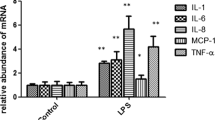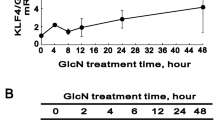Abstract
The purpose of the present investigation was to establish a cell culture system suitable for demonstrating the drug-induced lysosomal storage of sulfated glycosaminoglycans (GAGs). This is a drug side-effect which was previously studied in animals treated with the di-cationic amphiphilic compound tilorone and congeners, and which is likely to occur in humans, too. Cultured corneal fibroblasts of rats were exposed to tilorone for 72 h. They developed histochemical and cytochemical alterations indicative of mucopolysaccharidosis and resembling those occurring in vivo. The threshold drug concentration was found to be below 0.7 μM. The reversibility of the lysosomal GAG storage was low. An increase in the drug concentration to 10 μM produced additional unspecific lysosomal alterations, while the mucopolysaccharidosis-like lesions became less prominent. Concentrations of 40 μM and 80 μM caused unspecific cytoplasmic vacuolation and cell death, respectively. The present model system appears suitable for screening investigations of newly developed drugs with respect to their mucopolysaccharidosis-inducing potential and for investigating the structure-activity relationships underlying this adverse drug effect. Care should be taken not to use too high drug concentrations which cause unspecific lysosomal lesions.
Similar content being viewed by others
References
Barka T, Anderson PJ (1962) Histochemical methods for acid phosphatase using hexazonium pararosanilin as coupler. J Histochem Cytochem 10: 741–753
Brown WJ, Goodhouse J, Farquhar MG (1986) Mannose-6-phosphate receptors for lysosomal enzymes cycle between the Golgi complex and endosomes. J Cell Biol 103: 1235–1247
Buchheim W, Drenckhahn D, Lüllmann-Rauch R (1979) Freeze-fracture studies of cytoplasmic inclusions occurring in experimental lipidosis as induced by amphiphilic cationic drugs. Biochim Biophys Acta 575: 71–80
De Duve C, De Barsy T, Poole B, Trouet A, Tulkens P, Van Hoof F (1974) Lysosomotropic agents. Biochem Pharmacol 23: 2495–2531
Duchateau A, Zeitoun P, Escaig F, Leclerc A, Guillerm J-F (1980) Separation of epoxy-embedded cell cultures from plastic flasks for electron microscopy. Stain Technol 55: 225–228
Freshney RI (1987) Culture of animal cells. A manual of basic technique. 2nd edn. Alan R. Liss, New York
Gupta DK, Gieselmann V, Hasilik A, von Figura K (1984) Tilorone acts as a lysosomotropic agent in fibroblasts. Hoppe Seyler's Z Physiol Chem 365: 359–866
Hein L, Lüllmann-Rauch R (1989) Mucopolysaccharidosis and lipidosis in rats treated with tilorone analogues. Toxicology 58: 145–154
Kawamoto K, Hirano A, Herz F (1980) Simplified in situ preparation of cultured cell monolayers for electron microscopy. J Histochem Cytochem 28: 178–180
Lüllmann-Rauch R (1982) Histochemical evidence for lysosomal storage of acid glycosaminoglycans in splenic cells of rats treated with tilorone. Histochemistry 76: 71–87
Lüllmann-Rauch R (1983) Tilorone-induced lysosomal storage mimicking the features of mucopolysaccharidosis and of lipidosis in rat liver. Virchows Arch [B] 44: 355–368
Lüllmann-Rauch R (1986) Keratopathy in rats after treatment with tilorone. Graefe's Arch Clin Exp Ophthalmol 224: 377–383
Lüllmann-Rauch R (1989) Experimental mucopolysaccharidosis: Preservation and ultrastructural visualization of intralysosomal glycosaminoglycans by use of the cationic dyes cuprolinic blue and toluidine blue. Histochemistry 93: 149–154
Mellman I, Fuchs R, Helenius A (1986) Acidification of the endocytic and exocytic pathways. Ann Rev Biochem 55: 663–700
Ohkuma S, Poole B (1978) Fluorescence probe measurement of the intralysosomal pH in living cells and the perturbation of pH by various agents. Proc Natl Acad Sci USA 75: 3327–3331
Ohkuma S, Poole B (1981) Cytoplasmic vacuolation of mouse peritoneal macrophages and the uptake into lysosomes of weakly basic substances. J Cell Biol 90: 656–664
Pearse AGE (1961) Histochemistry — theoretical and applied, 2nd edn. Little, Brown & Co, Boston, p 781
Poole B, Ohkuma S (1981) Effect of weak bases on the intralysosomal pH in mouse peritoneal macrophages. J Cell Biol 90: 665–669
Prokopek M (1989) Drug-induced mucopolysaccharidosis in rats. Naunyn-Schmiedebergs Arch Pharmacol 339: R8
Rorig KJ, Ruben Z, Anderson SN (1987) Structural determinants of cationic amphiphilic amines which induce clear cytoplasmic vacuoles in cultured cells. Proc Soc Exp Biol Med 184: 165–171
Scott JE, Orford CR, Hughes EW (1981) Proteoglycan-collagen arrangements in developing rat tail tendon. Biochem J 195: 573–581
Van Kuppevelt THMSM, Domen JGW, Cremers FPM, Kuyper CMA (1984) Staining of proteoglycans in mouse lung alveoli. I. Ultrastructural localization of anionic sites. Histochem J 16: 657–669
Weiss JN, Weinberg RS, Regelson W (1980) Keratopathy after oral administration of tilorone hydrochloride. Am J Ophthalmol 89: 46–53
Wibo M, Poole B (1974) Protein degradation in cultured cells. II. The uptake of chloroquine by rat fibroblasts and the inhibition of cellular protein degradation and cathepsin B1 J Cell Biol 63: 430–440
Author information
Authors and Affiliations
Rights and permissions
About this article
Cite this article
Burmester, J., Handrock, K. & Lüllmann-Rauch, R. Cultured corneal fibroblasts as a model system for the demonstration of drug-induced mucopolysaccharidosis. Arch Toxicol 64, 291–298 (1990). https://doi.org/10.1007/BF01972989
Received:
Revised:
Accepted:
Issue Date:
DOI: https://doi.org/10.1007/BF01972989




